Anyone who has tried our hay nets knows just how beneficial they can be in the management of your horses, ponies, and livestock. There are numerous advantages to adopting a slow-feeding approach. However, have you contemplated the sheer multitude of these benefits?
We have identified at least 13 major benefits to slow feeding, some of which you might not be aware of! Please let us know if you have discovered other benefits that we don't have listed here.
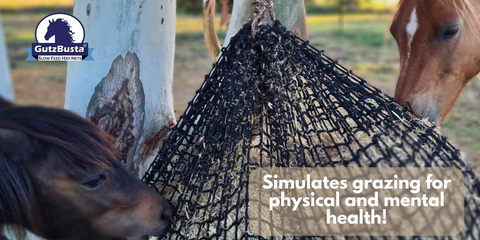
Benefit #1:Simulates grazing for physical and mental health - horses are supposed to eat 16-20 hours a day.
Most of us know that horses are supposed to eat 16 to 20 hours a day for both their physical and mental well-being. Access to fibre is just so critical for their digestive health, whether it be a horse, cow, sheep or any livestock.
There are so many negative health effects from not eating enough fibre and using slow-feed hay nets enables you to provide access to fibre for whatever period you would like. Be that 24/7 such as when you are using our Round Bale or Large Export Square (8x3x4 / 8x4x4) hay nets, or even our Extra Large (two small bales) or Large (one full small bale) hay nets that take a full small bale. Or if you want to provide shorter periods of hay access and a more constant feeding schedule, then you can use our Extra Small, Small, and Medium hay nets.
Starvation is one of the worst things to do when managing any laminitic, EMS, IR or any metabolic suffering horse. Constant stress causes cortisol to be constantly released which inhibits the coffin bone/hoof wall connection and therefore delays healing in the hoof.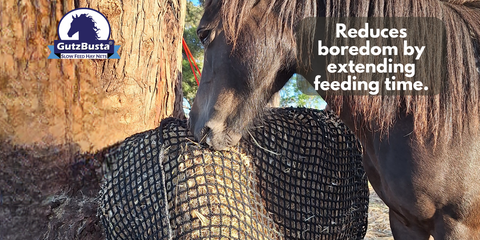
Benefit #2: Reduces boredom by extending feeding time.
Anyone who has spent time with horses knows that they can indeed get bored, particularly if confined to a stable, or yard, or they are housed by themselves with no other stimulation.
This is where our hay nets are an awesome enrichment tool to reduce the incidence of boredom. For animals that are supposed to eat for 16 to 20 hours a day, using a hay net not only allows you to control their feed intake, but also saves on wastage.
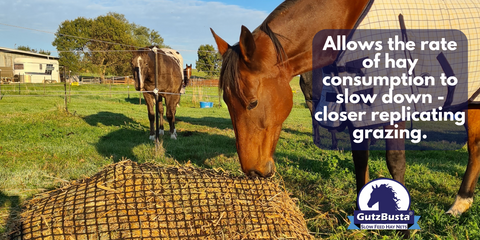
Benefit #3: Allows the rate of hay consumption to slow down - closer replicating grazing.
The beauty of having so many netting hole sizes available is that we can cater to whatever the individual needs and requirements of your herd or horses require.
As we know, there are so many variations in how each animal eats, from the Equine Labrador that hoovers the meal down without taking a breath to the old retired horse who seems to methodically chew 40+ times before swallowing each mouthful.
Clearly, the Labradors are best suited to the 2cm or 3cm (3/4" or 1 1/4") nets, and the oldies are best suited to the 4cm or more likely the the 6cm (1 3/4" or 2 1/2") nets.
We have a very thorough analysis of what factors there are to take into account when deciding what hole size will best suit your horses and ponies. There are just so many factors to consider, but the most important ones are:
- Aim - are you trying to maintain weight, gain weight, or lose weight?
- Type of hay - is your hay palatable (yummy), stalky, or not very palatable?
- Is your horse a greedy eater, average, or a slow eater?
- How much exercise, or what is the work routine of your horse (if any)?
We now have 2cm / 3/4", 3cm / 1 1/4", 4cm / 1 3/4" and 6cm / 2 1/2" holes, so we have a HUGE range of hay net hole sizes to manage every one of your animals speed of intake depending on their individual needs and requirements.
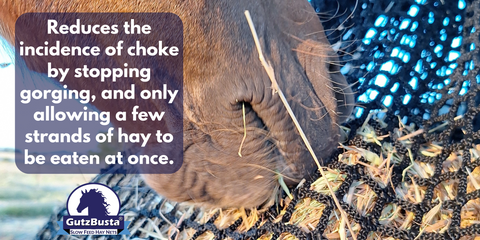
Benefit #4: Reduces incidence of choke by stopping gorging, and only allowing a few strands of hay to be eaten at once.
We have quite a few customers who have horses that have horses that choke. While I have never personally experienced this with my horses, the thought alone is terrifying.
Hay nets are an awesome and essential addition to the management schedule of horses that choke. With the amount of different hay net hole sizes we have, rest assured, that we will have a hay net to suit you and your horse or pony.
The benefit of a hay net is that it will also prevent gorging hay as the horses simply can't get large mouthfuls of hay out at a time and only strands, at a time as you get down to the 3cm / 1 1/4" and 2cm / 3/4" hay net hole sizes.

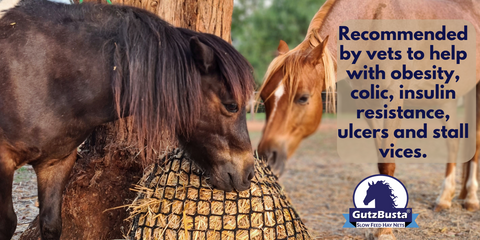
Benefit #5: Recommended by vets to help with obesity, colic, insulin resistance, ulcers, and stall vices.
- Obesity is as much a problem in the horse world as it is in the human world nowadays. Often from the same causes - not enough exercise, and too much-processed feeds. To help manage horses and ponies with obesity problems, our GutzBusta Hay Nets are an awesome addition to your management routine. Not only do they allow the regulation of feed intake with our various-sized holes
- Colic - The number one killer of horses!! I think as a horse owner, this is one of the biggest fears that we all have. There is nothing more heartbreaking and scary than seeing your horse rolling in severe abdominal pain. If you are far from a Vet, then it gets even more scarier. By maintaining a constant supply of food, therefore keeping the horses' gut healthy and happy, you are reducing the risk of colic when using one of our hay nets.
- Stall/Stable Vices - standing in a stall, stable, small yard, or paddock can be a stress in itself. Imagine doing this with nothing to eat for hours on end! Especially for an animal that is supposed to eat for 16 to 20 hours a day. How many times have you seen a biscuit/flake of hay thrown out on the ground simply to see it gobbled up in half an hour and the horse left standing there with nothing to eat for the remainder of the day until the next feed?
This is a HUGE benefit of using a slow feed hay net in that it takes the stress out of feeding and gives you peace of mind knowing that your horses and ponies ALWAYS have something to eat, or at the very least, only a couple of hours between feeds and not 10+ hours between feeds.

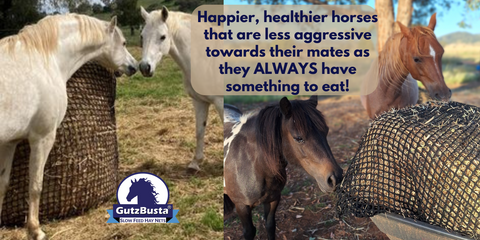
Benefit #6: Happier, healthier horses that are less aggressive towards their mates as they ALWAYS have something to eat, particularly if they are on a dirt lot, paddock paradise track, stabled or yarded.
We are repeatedly told by our customers that they are surprised by the calmness and loss of aggression in a herd situation that occurs when they start using slow-feed hay nets and keep them filled all the time.
When food is in constant supply, it removes the aggressiveness of the herd members as it takes that desperation feeling away and replaces it with security in knowing that there is always feed available.
This also aids in the reduction or removal of the 'standing at the gate' syndrome where the horses are standing at the gate calling out for their next feed.


Benefit #7: Great for laminitic, IR etc horses as there is no insulin spike if they have hay available all the time. Allows free choice/low carbohydrate hay access all the time.
Pasture/Meadow hay is usually the best (not ryegrass and/or clover hay as these are generally too high in sugar.)
- Insulin Resistance - Using a GutzBusta Slow Feed Hay Net also reduces the insulin spike that happens from periodic feeding. When they have a constant supply of low-sugar hay, there is no insulin spike compared to a horse that is thrown a biscuit of hay twice a day and given a hard feed once or twice a day. For those horses and ponies that are metabolically compromised (IR, Cushings, EMS etc), then this is a very important thing to manage.

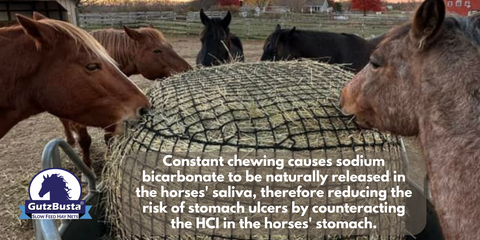
Benefit #8: Constant chewing causes sodium bicarbonate to be naturally released in the horses' saliva, therefore reducing the risk of stomach ulcers by counteracting the HCI in the horses' stomach.
- Stomach Ulcers - Way more common than most of us think and want to acknowledge. Something as simple as a horse seeing its mate loaded on a horse float or trailer is enough to cause stomach ulcers in some horses. Having a constant supply of fiber in their belly from using slow-feed hay nets helps reduce the incidence of stomach ulcers.


Benefit #9: Reduces hay wastage from being blown away, trampling mud, etc therefore saving money.
For people who live in high-wind areas, or on stormy days, there is nothing worse than throwing a biscuit/flake out to your horses, only to see it being blown away in the wind.
Equally annoying is seeing your valuable hay being trampled into the ground, used as a comfy bed, or worse.... seeing it being used as a toilet!!
Using a GutzBusta keeps your hay confined and unable to be wasted.


Benefit #10: Net types of slow feeders can hang anywhere and are safe, durable, and easy to fill.
Flexibility - as most of you know, we have an extensive range of sizes and shapes. To remind yourself of all the sizes and shapes (including measurements), take a look at this link.A brief summary of our sizes:
- Extra Small - takes 1 flake/biscuit
- Small - takes up to 3 biscuits/flakes of hay
- Medium - takes 4 to 7 biscuits or half a small square bale
- Large - takes a full small square bale of hay (2 stringer)
- Extra Large - takes two full small square bales (2 stringer) of hay OR for our US customers, it takes one 3-stringer square bale
- Round Bales:
- 3x4
- 4x4
- 5x4
- 6x4
- Large Square Export Bales (8x3x3/8x3x4/8x4x4)
- This hay net will fit all 3 sizes of large square bales.
One thing we feel is very important is that the nets need to be easy to fill. This is harder for smaller sizes, as our extra small hay net will only take one biscuit/flake of hay, so it naturally has a small mouth, however, smalls are very reasonable. Our mediums are over 1 meter or 3 feet wide and our Larges fill on the long side, therefore they have a huge mouth that is around 1.4m wide, or 4+ feet wide. The Mediums and Larges are a great size to use if you have to fill your nets from an open round bale or large square 8x3x4 bale where you have super large biscuits.
Our hay nets are safe to use, however like anything with horses, there is due diligence and common sense needed.
Under no circumstance should shod horses be allowed hoof-to-net access to ensure the longevity of your hay net and the safety of your horse or pony. They can be very safely used with shoes, but you need to tie them higher if they are the smaller sizes like extra small, small, medium or large sizes.
In the circumstance of using the Round Bales or Large Export Bales with shoes, you need to use a hay hut, hay ring, gates, or some other device or structure that will keep the netting away from shod feed.

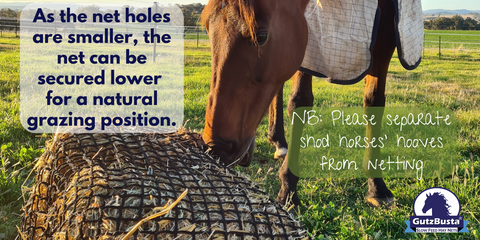
Benefit #11: As the net holes are smaller, the net can be secured low for a natural grazing position.
Due to the variety of sizes available, our hay nets are great to enable head-down grazing. This is of course, as long as your horses aren't shod!
If they are shod, then they will need to have their hay net hung higher (out of hoof range), or the net has to have a hay ring, gates, box or whatever device you come up with to help separate the hooves and the net.
It is also important to not have your hay net tied low if your horse's feet aren't regularly trimmed resulting in chips and splits or excessively sharp edges being present.
Be mindful of your horse or ponies hoof size. If they are a small pony and their hoof width is 4cm or 1 3/4" wide and long, then you wouldn't let them eat with hoof contact available, out of a 6cm / 2 1/2" hay net.

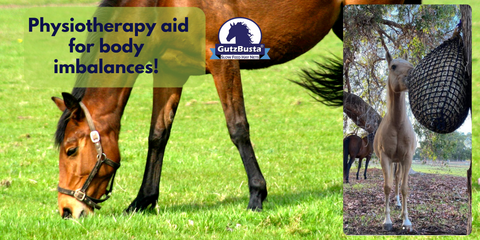
Benefit #12: Physiotherapy aid for body imbalances
Some of us have had the pleasure and awe of attending a whole horse dissection or equine biomechanics clinic with Sharon May Davis, who is heard to frequently reference the horse as being "the textbook on the table". By that she means that all the anatomy textbooks are a great 'aid', however, each horse doesn't follow the textbook and that is why the origin and insertion points of muscles are different in size, location, and appearance on many horses. That is why it is so important for equine bodyworkers to 'feel' the muscles when working on a horse to get a better understanding of that individual animal and its issues.
One concept that Sharon has come up with is 'Hay High', or what she now calls 'Passive Physio'. Both of these acknowledge that horses in the wild don't just have their heads down grazing, they also optimally spend 20% of their day browsing with their heads up higher, or even stretching right up to reach the leaves of trees.
An interesting observation of this is that when they are up a position of plucking leaves from a tree, they are usually standing with both feet together and therefore equally balanced.
This is why it is called passive physio as if you use a small GutzBusta Hay net with some nice hay in it and tie it high, the horse will stand even in front while it stretches to get its hay. For club-footed horses, this can be a very valuable tool to help manage and correct as much as possible, the smaller, more upright foot.
All of us note that when our horses are grazing, they have one leg stretched forward, and the other back. Doing this 24/7 will not aid the rehabilitation of a club foot as the club foot is ALWAYS the hoof that is back and not being loaded while grazing.
Other benefits of using this hay high system are that it can even aid in reversing the effects of ringbone, and improve core muscle strength.
Using the hay high method in your daily routine can aid in improving performance due to improvements in posture and health.
Please consult with your own Equine bodyworker or Veterinarian to assess what is right for your horse, and do not exceed more than 1 hour a day in feeding with your hay net in a high position.


Benefit #13: Time and labour-saving
As we have mentioned, we have so many different sizes and shapes and quantities of hay that can be fed out with a GutzBusta Hay Net. This gives you the flexibility to decide the how, what, where, and amount of hay that you need to feed to your horse daily.
Maybe your horse is out at pasture, but you just want to add a little more forage/fibre to his diet, so in this case, a small might be more than adequate.
Maybe you need to put a medium out as you work long hours and only get to your horse once a day.
Using the large bale nets so that horses have access to hay for longer periods before refilling can also be of great assistance as you can put a full small bale of hay out at any one time.
Round bales are even better or the Large Export Bales, as these can last weeks, if not months, depending on the individual horses, but work best if they are under shelter if rainy weather is a common occurrence. We do, however, have some great wet weather ideas here!
_____________________________________________________________________________________________
Please Note: The ideas and topics presented here stem from our extensive experience with GutzBusta Hay nets over the past 13 years. Each farm, horse, and management routine is unique, as are individual behaviors and habits. Therefore, we recommend seeking advice from your local Veterinarian, Equine nutritionist, or another Equine practitioner who is knowledgeable about you and your horses before making decisions that may impact your animals!









